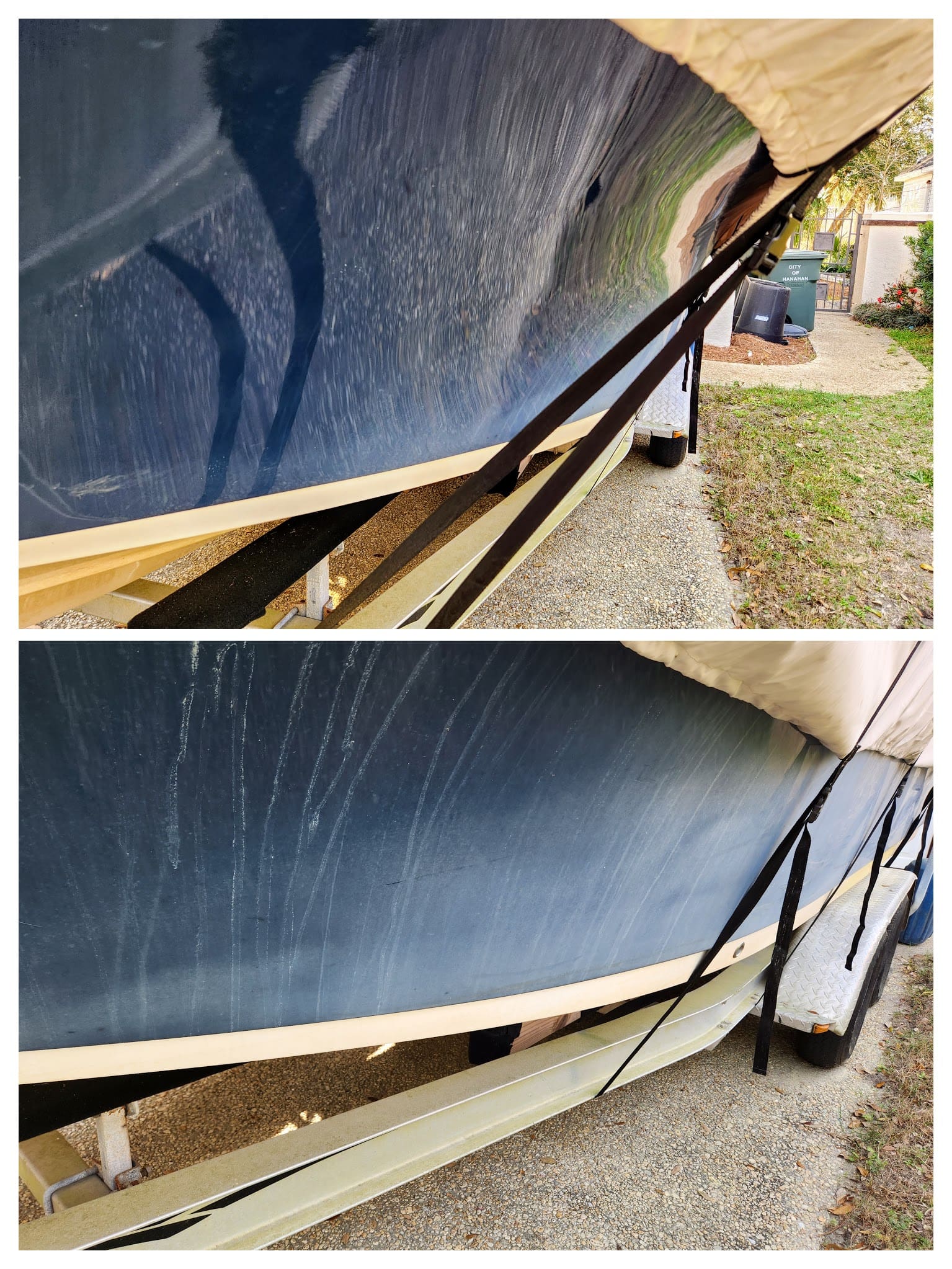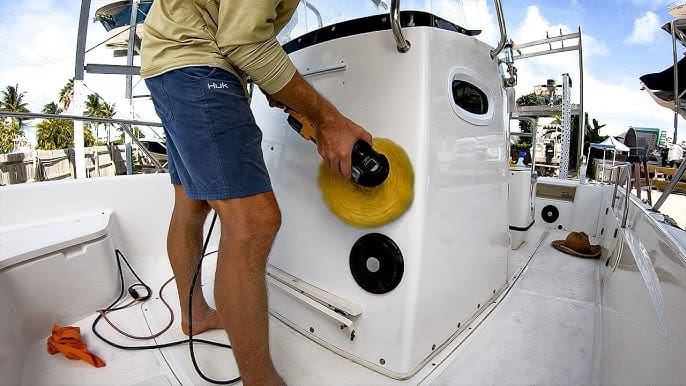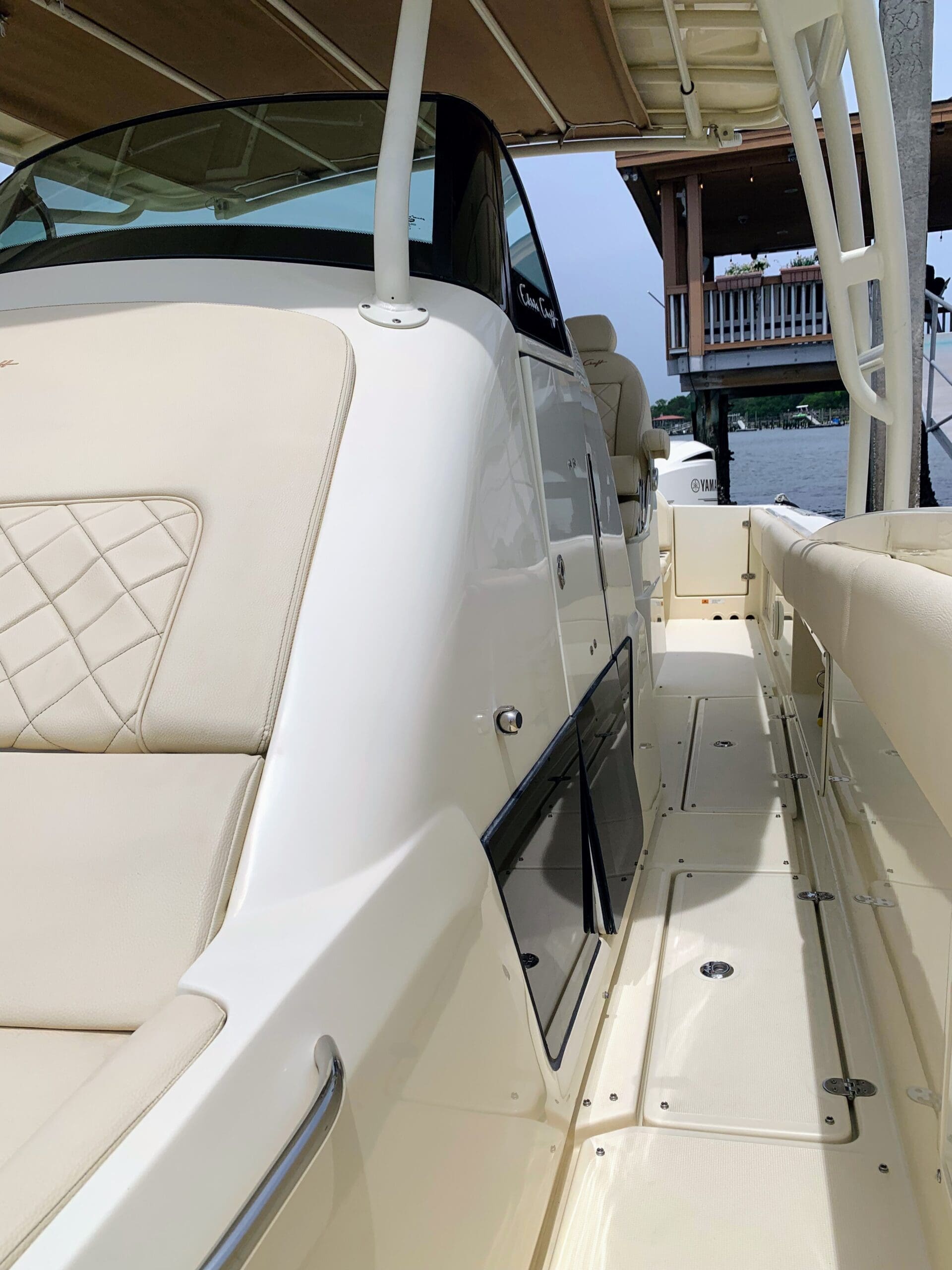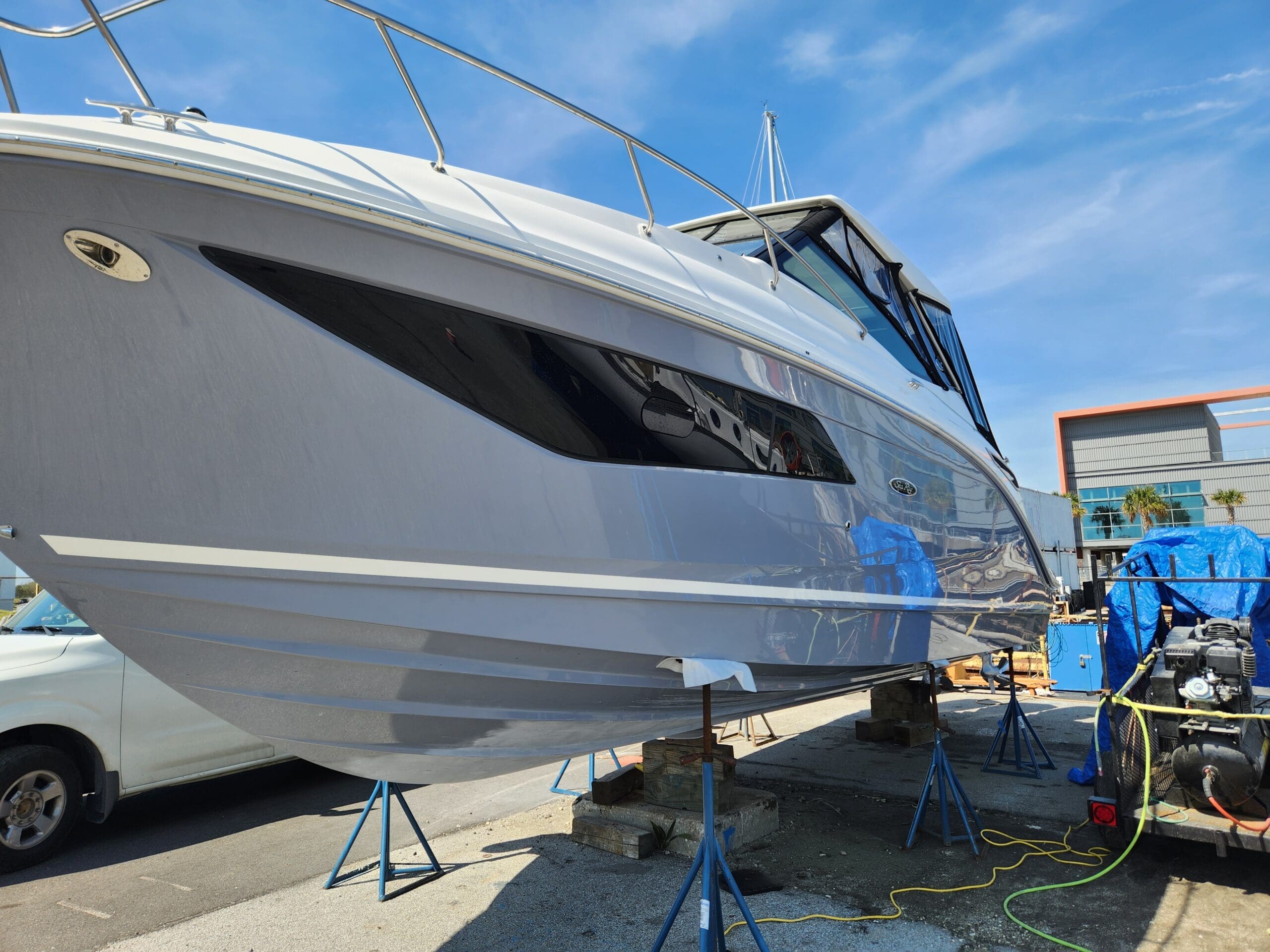
Photo of saltwater maintenance competed on a yacht
Saltwater Boat Maintenance Tips For Beginners
New to boating on the east coast? Here you can learn a simple saltwater boat maintenance routine that covers your hull, gelcoat, engine, corrosion, and storage plus a few local tips for Charleston, Hilton Head, and Savannah.
Why Saltwater Maintenance is Important
Saltwater coupled with the UV rays of the southern summer sun is what boating from Charleston to Savannah is all about. However, it can also be unforgiving. The same warm, nutrient-rich water that makes the Lowcountry special also accelerates oxidation, galvanic corrosion, and marine growth. The good news is a simple and consistent routine prevents 90% of that avoidable damage which not only protects your boat but it’s resale value.
Do This Simple Checklist After Every Use (10–20 Minutes)
- Fresh-water rinse from top to bottom.
Work from hardtop/t-top to deck down to the bottom of the hull. Use a gentle, pH-balanced boat soap (not household detergent like Dawn). Ensure the label reads “wax” or “won’t remove wax”
Locals Tip: Pluff mud splatter around Charleston and Savannah sticks so rinse it off before it dries for easier cleanup. - Engines: Flush thoroughly.
Follow your engine maker’s procedure (muffs or built-in flush). Let it run long enough to reach temp and evaporate residual moisture. Pro Tip: Do this while the engine is hot/warm as it clears out salt faster and more effectively. - Dry and spot-protect.
Towel or squeegee brightwork (stainless) and electronics. Mist a corrosion inhibitor on hinges, latches, steering components, and electrical connectors. - Inspect and clear.
Check the bilge for water or rainbow sheens (fuel or oil), empty fish boxes, and remove wet lines, life jackets, and cushions to air out. Around your engine look for any hoses, clamps, weeping fuel, frayed control cables. Check your prop(s) for fishing line or braid around the shaft? Remove and inspect monthly during peak season, this will blow your lower unit seals. - Cover correctly.
A breathable, UV-resistant cover saves hours of cleanup later. Avoid trapping moisture.

Follow Your Engine Maintenance Schedule
If You Bought New
- Typically at first 20, 100, 300, etc: Check with your engine manufacturer (most are posted on their websites).
- The Engine Service Itself: You can do it yourself and it will not void warranty (common misnomer).
If You Bought Used
- Always Have It Serviced Upon Purchase: This way you know that it’s been done and can track the hours for when it needs it in the future. You can set a timer on most digital gauges at the helm that will track it for you.

Before (bottom) and After (top) photo of the removal of oxidation and UV damage from a boat hull on boat detail in Charleston SC
Protect Your Gelcoat, What Beginner's Typically Miss
The shine of your boat hull is probably one of the things that attracted you to the boat in the first place but yet is one of the most overlooked after purchase. The main reason is new boaters equate a new boat with a new vehicle’s paint job which they prove last an extremely long time with little to no upkeep. However, a vehicle paint job is typically covered with multiple coats of clear coat (a clear based paint that adds gloss and protection). Your boat hull is not paint, it’s gelcoat and it has no protection unless you put it on. Gelcoat is porous like your skin and needs wax like your skin needs sunblock. Without any protection, your gelcoat will begin to breakdown lose its gloss, take on a hazy or chalky appearance and become increasingly susceptible to staining or discoloration.
There are a plethora of options to protect your boat’s gelcoat today. Basically, you need a wax that can be applied to the surface. However, while that seems like a simple task it can prove challenging based upon a few criteria. You need to ask yourself: how much time do I want to invest into this (it’s definitely going to take longer than you think), how fit am I to accomplish the task (the bigger the boat the more surface area to cover), and most importantly how much do I care about what it looks like? If you do care, then hire a pro to detail the boat. If you don’t care, you have the time and muscle then you should do it. Pro Tip: If the back of the label says it can be removed by hand – they are lying to you. Ha, well maybe not fully but you will be Mr. Miyagi by the end of the day.

Photo of polishing a boat and sealing it with an Si02 sealant
Electrical & Electronics (Salt’s Favorite Target)
- Connections: Heat-shrink, marine-grade butt connectors, dielectric grease on plugs.
- Battery health: Charge your batteries per manufacturer specs, this is one of the biggest causes to boat failure.
- Bilge care: Keep it clean and dry; check float switches and pumps by manually lifting floats.
- Electronics: Marine Electronics are made to endure short periods of water. However, after use during storage it’s very important keep it dry and keep it aerated. If you store your boat under a cover, keep console door open. If you don’t have a cover, keep cracked to allow air flow.
Boat Upholstery Maintenance

Photo of a center console boat with a marine upholstery protection added in Charleston SC
- Rinse salt, then gentle soap.
- Apply a dedicated vinyl cleaner + UV protectant application on all cushions.
- Place easily removable cushions out of the elements when not in use.
- Or keep out of direct sunlight exposure.
Local Knowledge: Charleston • Hilton Head • Savannah
- Brackish switches: Stretches of Wando, Ashley, and Savannah Rivers can swing salinity fast. Inspect anodes and electrical connections more frequently if you split time between fresh and salt.
- Pluff mud: These can stain hulls; don’t let splatter sit.
- UV & heat: Canvas and vinyl degrade quicker here so apply protectants on a schedule and not when they “look” dry.
- Big Tides & current: Dock lines see more friction. Use chafe gear and inspect frequently.

Photo of Johns Island Yacht Harbor where Total Boat Repair performs boat details, gelcoat repair and fiberglass repair.
Local Knowledge: Charleston • Hilton Head • Savannah
- pH-balanced boat soap, soft brush (hull), deck brush (nonskid), microfiber towels
- Vinyl cleaner + UV protectant
- Corrosion inhibitor spray, dielectric grease
- Marine wax or SiO₂ spray sealant
When to Call a Pro (and What We Do)
DIY maintenance goes a long way, but certain issues deserve trained hands:
- New Boat (new or used) detailing so you know your starting out on the right foot
- Gelcoat and fiberglass repairs; if you bought a used boat and want it fixed up right
- Our boat upholstery team can design a new look for you
- If you plan to keep the boat in the water, Total Boat Repair offers bottom painting near you
We offer mobile boat repair in Charleston, Hilton Head, and Savannah including fiberglass and gelcoat repair, boat detailing and boat upholstery.

Photo of a yacht that has just been detailed after a gelcoat repair
FAQs (Beginners Ask These First)
How often should I flush my outboard in saltwater?
Every single saltwater outing. Skip it and corrosion starts inside the cooling passages.
Do I need bottom paint if I keep my boat on a lift?
Usually no, but you’ll still get a scum line—plan on periodic hull washes.
Are aluminum anodes better than zinc here?
Aluminum performs very well in salt and brackish water and is widely used; just keep anode types consistent.
How often should I wax?
In our sun and heat, quarterly protection is a smart baseline if you’re on the water most weeks. At bare minimum at least twice a year.
If You Need A Hand
If you’d rather spend your weekends on the water—not scrubbing, waxing, or troubleshooting—book a service visit by calling 843-940-1008. We cover Charleston, Hilton Head, and Savannah with mobile teams that handle detailing, fiberglass/gelcoat repair, marine upholstery and bottom painting. Get an estimate today.
